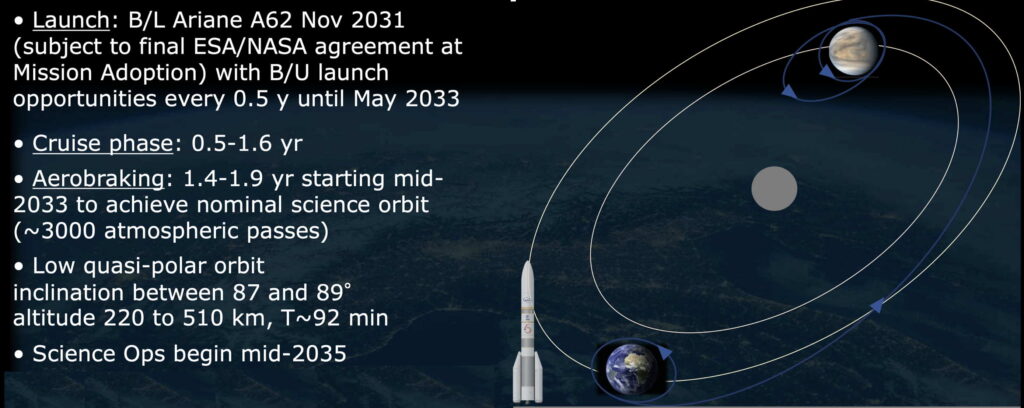Page updated 18 May 2023
EnVision: overall mission design
The baseline mission operational point for achieving the required science data return is tuned by design optimisation at mission level, combining space and ground segments. This mission-level operational point allows retrieving the required data return while minimizing spacecraft resources and for an acceptable load on the ground segment.
The mission design needs to accommodate the operation of the science instruments, namely VenSAR (standard, stereo, polarimetry, HiRes, altimetry, nadir, near-nadir and off-nadir radiometry modes), SRS (high and low density modes), VenSpec-M, VenSpec-H (cooling and nominal), VenSpec-U (Nominal and SNR- limited modes) and Radio Science Experiment (gravity experiment and radio-occultation experiment) such as to achieve the mission objectives in terms of surface coverage and repeated observations, while taking into account the constraints posed by the spacecraft design (e.g. wheel offloading manœuver duration and frequency, slew manoeuvers for pointing, mass memory capacity constraints, thermal and power constraints), the instrument design (e.g. VenSpec-M operates on the night side, VenSpec-U operates on the day side, cooling of VenSpec-H is required) and mission boundaries.

Programmatic boundaries: design-to-cost drivers
The mission is designed to achieve all of the prime key science objectives with a cost-at-completion compatible with the programmatic boundaries on ESA’s 5th Medium class call. This so-called ‘design-to-cost’ approach is a driver for key design choices for the mission architecture. For extensive information on conceptual design, design-to-cost drivers, science observations planning strategy, we point the reader to Chapter 5 of the Assessment Study Report available at the following link.
EnVision: Ariane 62 Launch, transfer and aerobraking phases
EnVision is required to be launched with Ariane 6, the new generation European launcher, in its dual booster configuration (Ariane 62). The baseline launch period opens end Nov 2031 for about 20 days (subject to final ESA/NASA agreement at Mission Adoption) with back-up launch opportunities every 0.5 years until May 2033. After opening of the launch period, launch opportunities are one per day, with days excluded due to the Moon gravity. The launch trajectory is also optimised to allow full visibility from ESA ground stations during the three hours following launcher separation.
EnVision design is fully compatible with back-up launch opportunities with a combination of shorter direct transfer, longer aerobraking phases compared to the baseline launch date. An alternative launch date also involves a long interplanetary transfer with an Earth swing-by.
Science orbit geometry requirements
EnVision’s required science orbit is a low, quasi-polar orbit with inclination between 87 and 89°, an altitude of 220 to 510 km above ground, with a resulting orbital period of ~92 min. The choice of science orbit around Venus is mostly driven by the radio science (RSE) gravity experiment and the operational altitude range for the SAR and SRS instruments. The former requires a low altitude polar orbit, with at least 40% of the time spent below 260 km over at least six cycles to reach degree strength of 90 over the full Venus surface. The latter requires the observations to be done at altitudes lower than 500 km to achieve good imaging qualities with high incidence angles.
